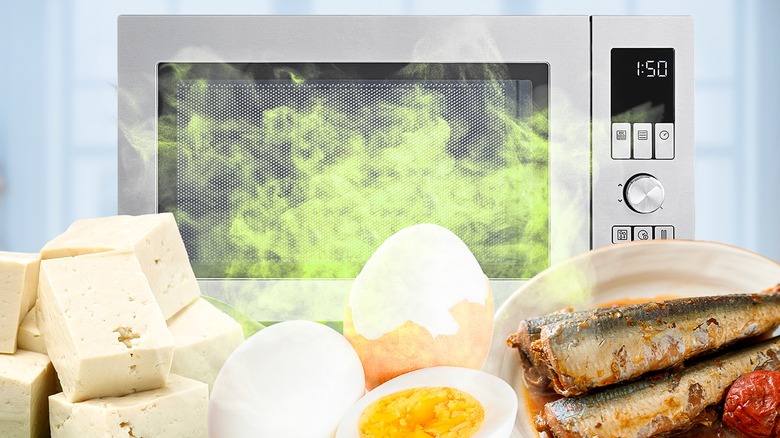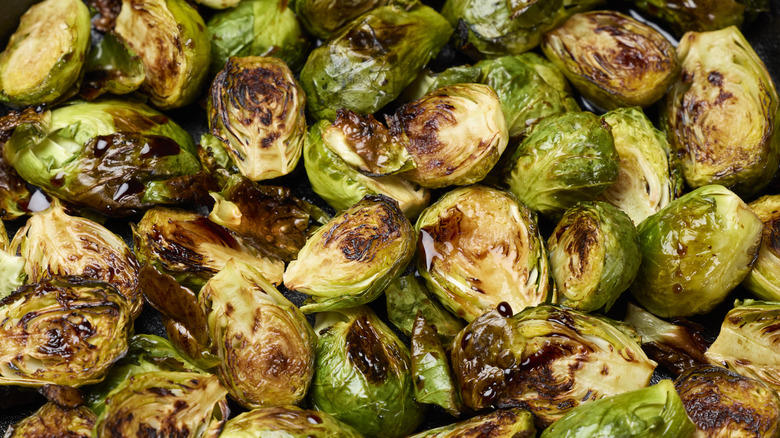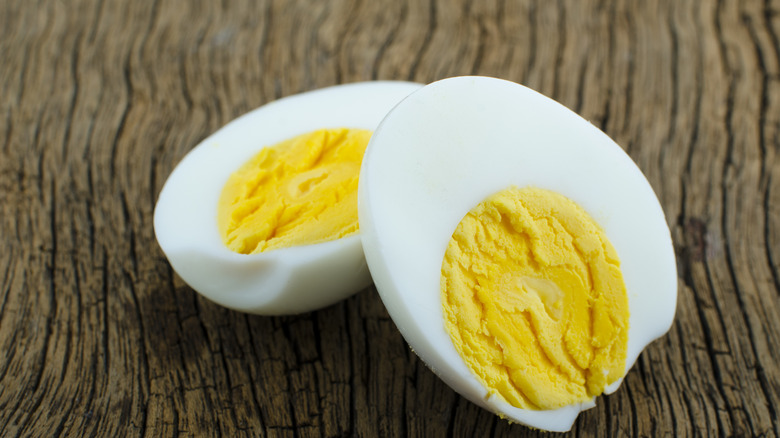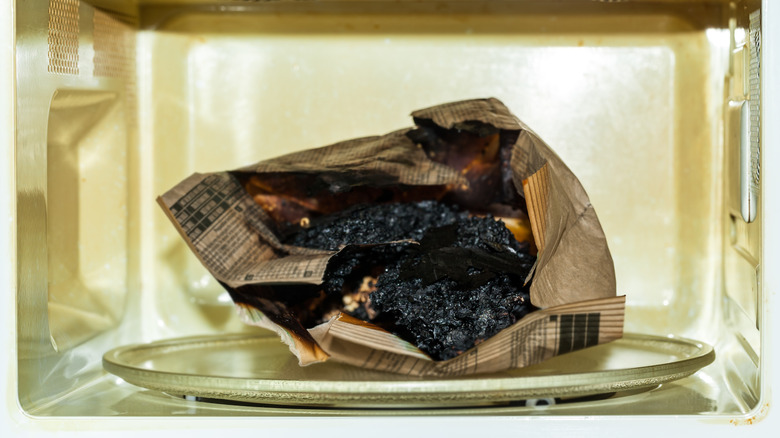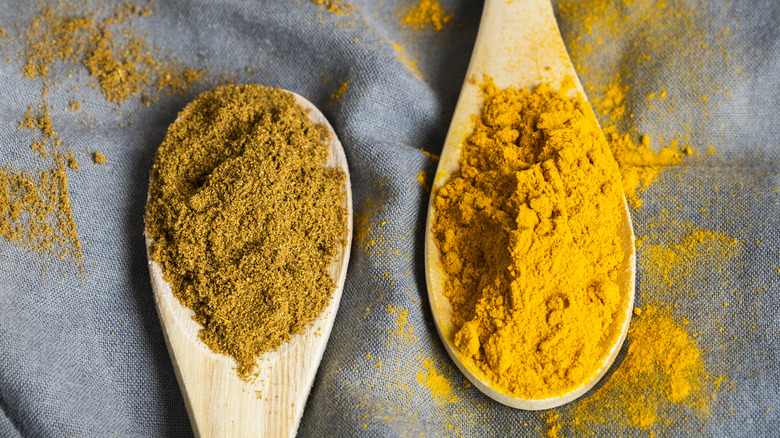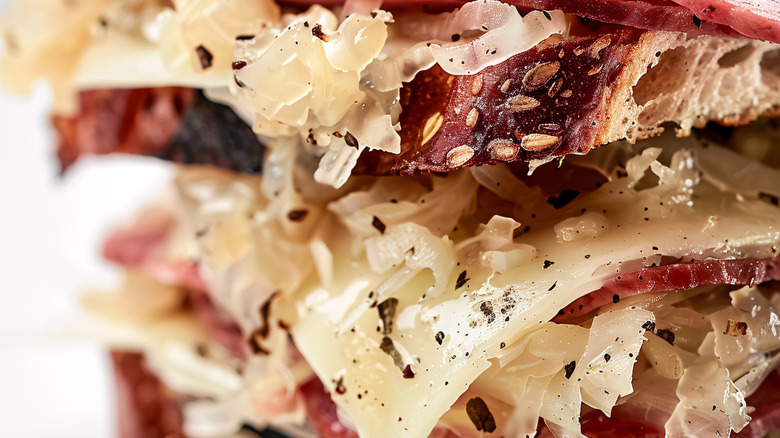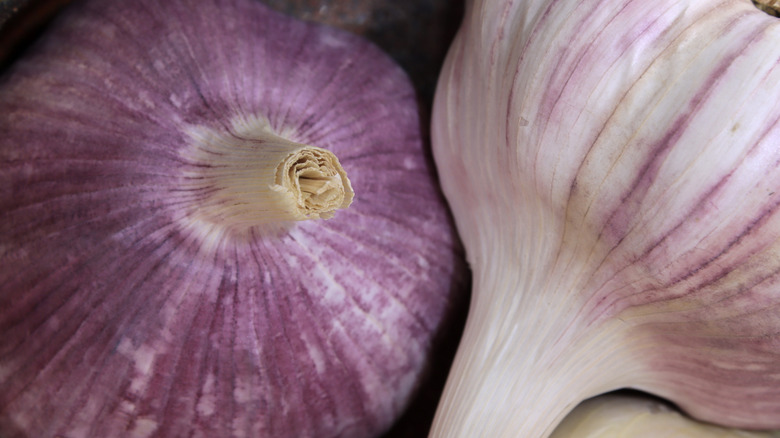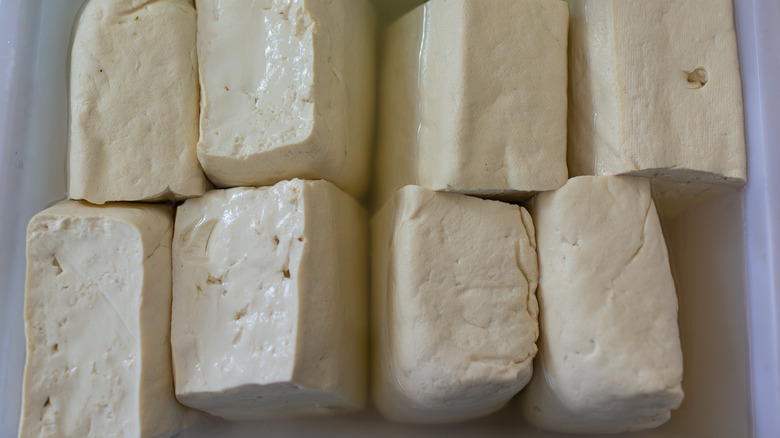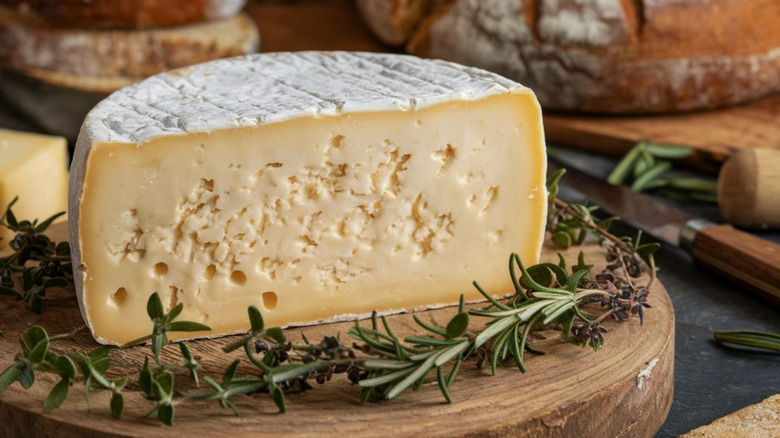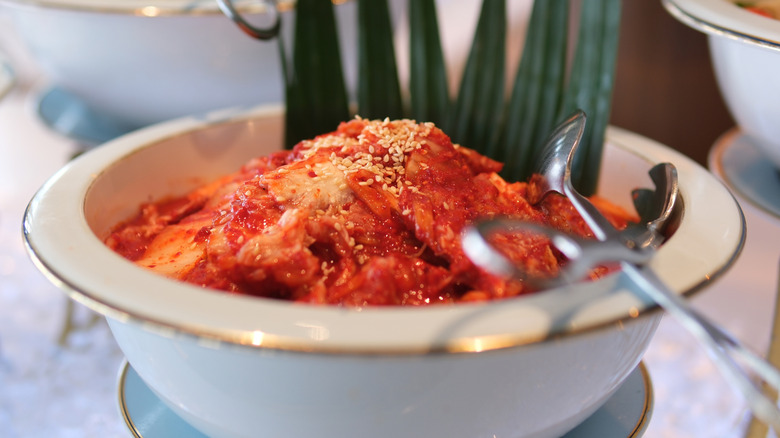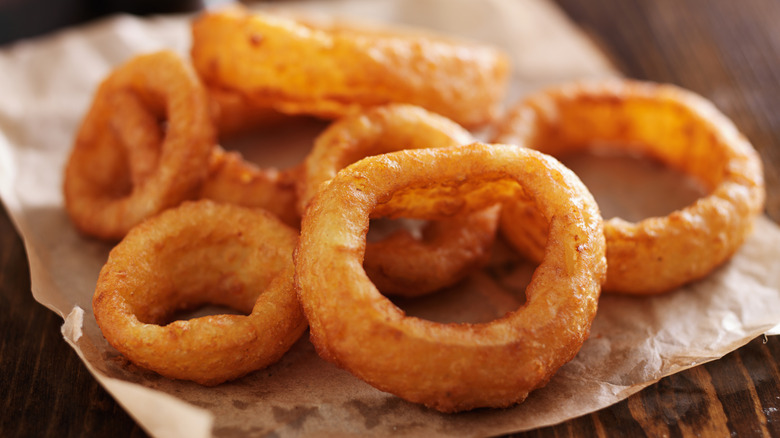Microwaving These 12 Foods Will Make Your Kitchen Smell Like Regret
The microwave is a time-saver and a game-changer in the kitchen. But it can also stink up the joint like nobody's business. It's a cruel twist of olfactory fate that often, the very chemical specifics that make a food nutritious, delicious, or both can also contribute to a mighty stench. The unique cooking process of the microwave, using electromagnetic pulses to generate heat, is part of the reason. And, this high-tech cookery triggers chemical reactions in the food not experienced when roasting, steaming, or using other cooking techniques.
This stinky onslaught can be especially pesky when the appliance is shared, notably in an office where the windows are sealed shut. Just as you naturally have the good graces to scarf down your smells-like-death durian fruit in the parking lot, far from discerning noses, keep this guide in mind when you're planning to nuke something, especially in a communal space. Or if you ever intend to have guests over at any time in the future. Geneticists observe that as humans, our sense of smell is declining, but that won't happen soon enough for you to de-stink your pad after a major burnt-popcorn incident.
Brussels sprouts
Yeah, they're great for colon health. But these gassy fiber-bombs can clear a room faster than a skunk in heat. Other cruciferous veggies (cabbage, kale, chard, mustard greens, bok choy, radish, turnip, broccoli) are equally redolent. They're crisp and crunchy when raw, and rain down a cloud of stank-particles once cooked. The sources of the stank are bioactive glucosinolates, sulfur-nitrogen compounds which activate when the plant tissue is damaged — in other words, cut open, or nibbled. These bitter-tasting compounds developed over the course of millennia as self-defense for the plant in the wild, fending off harmful fungi, molds, hungry insects, and other foragers.
The challenge for us humans: current studies suggest that glucosinolates fight oxidative stress in the form of free radicals, protecting our cells from DNA damage and potentially blocking the activity of carcinogens. The higher the concentration of glucosinolates, the more powerful these effects are, and the more bitter-tasting and foul-smelling the plant becomes. So there's the rub. These veggies emit their stink much like a skunk, as a means of self-protection. But unlike the skunk, the protective properties of these plants extend to you when you eat them. Which we recommend that you do — just skip microwaving them in the break room please.
Cauliflower
This dense cluster of cruciferous florets is good for you, and delicious when roasted or blanched to tenderness. But it's not ideal for the microwave for a couple of reasons. Cauliflower is among the veggies that often "spark" or arc in the micro because of high mineral content, which also explains its unmistakable odor that smacks of decomposition and damp basements. The arcing effect also prevents the food from heating through thoroughly. True to its name, cauliflower is indeed floral. That big, firm globe of white, purple, green or yellow crunchiness is in fact an edible nosegay of immature flower buds. We say "nosegay," but your nose may not feel especially jolly once those florets have entered the microwave.
As with other cruciferous vegetables, heat plus sulfur equals a hovering miasma of hydrogen sulfide, summer garbage-strike stench. Microwaving makes it worse, since most likely cauliflower in the micro is being cooked for the second (or third) time, and therefore is actually overcooked. Longer cook means stronger stench.
Eggs
Possibly nature's perfect food, yet hard-boiled eggs in the shell in the micro will literally explode, blasting diabolical-smelling waves of sulfur into hyperspace and sending all life-forms in the line of fire scrambling for cover. Sulfur-containing proteins are the stink-source here, especially when the egg is cooked too long, and most especially when the egg is cooked again in the microwave. How to tell if your free-range cackleberry is overcooked? That weird, gray-olive green ring around the hard-boiled yolk is the tip-off.
When the egg has endured too much heat for too long, the natural sulfur compounds present bind with iron in the yolk, resulting in an aroma which might otherwise signal a gas leak (we mean the kind in your kitchen) or perhaps the foul, bird-killing fumes spewing from an active volcano. All of this is accelerated because microwaves cook food fast.
TBH, hard boiled eggs always emit some level of funk, even when kept cold, chopped into a chilled mayonnaise base for a salad or sandwich. The aroma grows more and more developed, as they say in wine circles, the longer the egg sticks around. On the plus side, your microwave can be a great way to poach an egg, and it's also possible to nuke a leftover omelette without too much gag-factor.
Microwave popcorn
For generations of movie-goers, the aroma of melted dairy butter drizzled over freshly popped popcorn at the concession stand has been a solid audience-pleaser. But your attempts to replicate the experience with microwavable brands are likely not as enticing. Two reasons: the heating method, and the synthetic flavored topping. Normal browning of food employs the Maillard reaction, but overheating in the microwave — it's tough to get the timing right – triggers something called destructive distillation, a process which produces new chemicals. But the worst is yet to come: overheated fake butter, not the kernels, is what stinks when microwave popcorn burns, and the fumes from the most commonly used butter substitute, containing diacetyl, may even be hazardous to your health.
High heat unleashes a volatile organic compounds that carries a powerful scent-signature that gets more fierce, more funky with time. This means that burning your popcorn is just the beginning. The VOCs land on the inside of the microwave, and may even penetrate the plastic surfaces, coming back to life every time you hit the power button.
Fish
What makes fish, especially oily, cold-water fish like salmon and sardines, delicious and nourishing is their high concentration of healthful fats. Under heat, their oxidized fats are accompanied by an aroma that can quickly go from a fresh whiff of sea breeze to a long snort of old socks. And seafood spoils faster than land-based proteins, because many aquatic food sources thrive in cold water, and their cold-loving companion bacteria thrive along with them. Those specialized bacteria continue to happily proliferate, even on a bed of ice at the market or inside your fridge.
Live fish pulled straight from a body of water generally do not stink. But once on dry land, rapid changes occur in response to temperature and oxygen. Normally harmless microbes in the critter start to get too big for their bacterial britches, and soon emit a knock-ya-down, ammonia-like reek that's a clear warning of spoilage. Of course no one knowingly microwaves spoiled fish, but a blast in the micro breaks down those luscious omega oils and speeds up the production of trimethylamine (TMA). Each time the fish is reheated, more TMA is released, creating an odor which sadly leads many people to cringe at the thought of anything with fins.
Cumin
The best way to curry favor among co-workers and family members is to keep foods highly seasoned with cumin out of the microwave. Both cumin and human sweat (feet and underarms) contain the volatile organic compound (VOC) p-cresol. Which explains why some people think it smells like body odor. Throw some cumin in the microwave and it is the equivalent of "blooming" the spice intentionally, but the effect is far from mouthwatering.
Cumin belongs to the same family as coriander, parsley and celery, but trained noses who identify cumin in perfumes state that it carries an animal-like note, reminiscent of civet musk. Its warming, earthy, slightly citrus-y qualities do give dimension and depth not only to South Asian foods but also to savory pozole, chili, birria, and many other Mexican and Tex-Mex dishes. And let's not forget falafel at its funkiest! Microwaving tends to deconstruct and simplify the aroma profile, meaning that subtleties are lost and the acridity of cumin, stripped of its aromatic companions, grows more and more prominent to the point of becoming overpowering. An aside: eating lots of cumin further expands the reach of the aroma, since the essence of the seasoning enters your bloodstream and scents your skin, breath and urine.
Sauerkraut
What's in a name? A lot, actually. In German, "sauer" means "sour" or "angry." Even fans liken the stench to a whiff of dirty diapers. So blasting a bowl of fermented cabbage brimming with lactic acid lives up to its name. Not only does sauerkraut bring the innate smelliness of all things cruciferous to the table: it's fermented, and those probiotics truly put this bratwurst and Reuben sandwich accompaniment in a league of its own when it comes to pure P.U. Adding to the tsunami of stink when heated is the fact that you're probably nuking your kraut with something equally aromatic, usually salty, spicy, fatty smoked meats like corned beef or pastrami. These cured proteins emit a powerful force field all their own, generally alienating anyone within nose-range who isn't in a New York deli state of mind.
Raw cabbage contains natural sugars, which is why very fresh red cabbage especially is wonderfully sweet when chopped into a salad. Adding salt to a quantity of shredded cabbage draws out the natural moisture from the leaves creating a natural brine, and converts the sugars into lactic acid through the process called lacto-fermentation as the mixture bubbles away for several days or weeks. And lactic acid, fermented by several types of bacteria, is what makes yogurt sharply acidic unless artificially sweetened. Nuking that half-sandwich heaped with sauerkraut may seem appetizing, except that the deeply funky odor will persist long after your hunger pangs have vamoosed.
Garlic
Garlic is praised for its alliinase (an enzyme) umami, and also for its supernatural abilities to fend off the undead. The unmistakable, sexy-to-some perfume of the so-called stinking rose lingers on long after microwaving, perhaps reaching over into the other side. But really, if you eat anything other than Miracle Whip on white bread, you can't banish garlic from your menu. When used skillfully, garlic can add rounded depth and subtle complexity to a simple bowl of soup or otherwise unremarkable chunk of bread. For centuries, humans have not only enjoyed garlic for its taste but also for its antimicrobial properties. Science now knows that eating garlic may help lower blood pressure and bad cholesterol levels, and helps the body fight infection.
But here's the thing. Garlic gets uglier and uglier, the more you mess with it. Slow-roast it whole in the oven, it's like butter. Chop and mash it raw, it stings like a stingray — and stinks. Using the microwave to reheat a dish containing garlic may be the ultimate insult to this savory bulb, which grows incrementally more potent the more you handle it, overwhelming gentler seasonings in your dish. Being pummeled by those electromagnetic waves strips away garlic's softer side, and she comes out fighting. However, if you keep your eye on the timer, your microwave can make peeling garlic a fairly unstinky snap.
Stinky tofu
In an increasingly protein-seeking world, tofu leads the pack as a versatile food with unlimited potential. But this soy superstar is not without its challenges, notably its nose. In Mandarin, chou dòufu unapologetically translates as "stinky tofu," a night-market fave in much of China and especially Taiwan, where stinky-stands may literally be detected from blocks away, no street address or map required. This fermented soy product, often bolstered with fermented milk, dried shrimp, and amaranth leaf brine, in particular requires a cultural reality-check. Considered a delicacy across Asia, many people experience the aroma as pleasantly "nutty." Some of us are not so sure, picking up a bleach-like scent note from the calcium chloride or magnesium chloride used to coagulate commercial tofu. Microwaving dries out the normally-juicy tofu, further concentrating its funk.
Today, the aggressive stink is so essential to the dish that factory-made stinky tofu includes extra days in the brine-bath to add aroma. Chinese folktales maintain that stinky tofu happened by accident when a scholar forgot to check on his soybeans. Should you choose to fire up a few cubes of chou dòufu in the microwave, anyone within sniffing range may wish that they, too, could forget what they just inhaled.
Rind-washed cheese
Rind-washed cheeses in particular broadcast their mold-bearing ripeness in waves of odor that may have roommates asking "Who let the dogs out?" since the fromage emits an odor chemically identical to the fragrance of long-unwashed feet. Aficionados call the bouquet yeasty, woodsy, musky, and animal-like when describing rind-washed faves like Limburger, Taleggio, Bossa, and Appenzeller, comparisons which may require imagination.
Fondue, mais oui, but please fond-don't in the microwave. The developing, briney, edible rind and gooey texture makes rind-washed cheeses the perfect melt for nachos and more. But there's a stinks-to-high-heaven price. The twist: while the periodic "washing" with saltwater brine or brandy suppresses mold, doing this also fosters the flourishing of the same bacteria that breaks down the cheese proteins to release methanethiol, the very compound that leads people to jettison their well-worn tennies. And there are other compelling reasons to forgo nuking cheese.
Microwaving cheese can ruin it as it makes the proteins clump together, coagulate and bunch up into icky solids, surrendering much of their succulent moisture. The result resembles a ball of rubber cement from a craft project gone bad. When the protein matrix is broken and the fat liquefies, cheese loses its velvety, tensile integrity. But really, the most pressing reason not to microwave rind-washed cheeses is the smell. Just as vigorously rubbing a cologne into your wrist actually damages the molecules, microwaving cheese distorts both the flavor and aroma profiles, leaving a sour, curdled-milk vibe in the atmosphere.
Kimchi
Kimchi is the proverbial Swiss Army knife of Korean cuisine. Its origins are humble, but noble, and today this salted, fermented pickle dish symbolizes Korean cultural pride as well as serving to brighten and heighten flavors of myriad regional dishes. There's just one problem: the smell, especially when unleashed in close quarters. True devotees eat the funk-o-licious condiment most often made from daikon radish and Napa cabbage straight from the jar, but it's also a classic when finely chopped into fresh, hot rice, atop the grains of a bibimbap bowl, in savory fritters and pancakes, in stews, egg dishes, on noodles and chicken. Those who truly love it save the liquid at the bottom of the jar or pot to add to sauces and salad dressings.
The usual factors come into play, starting with high sulfur content that becomes especially penetrating when the food is heated. But kimchi kicks everything up a notch with a bushel of high-test aromatics including garlic, ginger, scallions, fish sauce, fermented shrimp paste, and gochugaru (Korean chili powder). Korean folkways and foodways are filled with references to kimchi in the form of proverbs called Sokdam, using the dish as a familiar metaphor. We love ancient wisdom as much as the next person, but the combo of heaps of crushed garlic, sour-milk wafts from lactic acid, and even the release of carbon dioxide from the mix can render any small space unbearably pungent for the faint-hearted.
Onion rings
The onion ring moves through the world with an unpretentious, Midwestern charm. Purist opine, but really, there are few rules. Big, sweet onions are best for the slice, and buttermilk in the batter is great. Modern tastes lean toward a very thin, tempura-style coating, but honestly, if you plan on dunking your rings into ranch dressing or ketchup sometime during the wee hours of the morning with an adult beverage, there's no need to get all prissy.
Fresh out of the sizzling oil, they're crispity-crunchity and impossible to resist. But nuked the morning after, not only do they never crunch the same way — and they just fill the space with the sulfurous tang of the onion itself and the truly sad smell of stale cooking oil. Nuking onion rings isn't just unkind to those around you who have to breathe the rather sickly fumes of an onion that has given up the ghost and fat that's past its prime: it's unfair to you, as someone who knows a good thing when you see it. And, worst of all, it's unfair to the onion ring. As with all fried foods, microwaving causes the water molecules in the onion ring batter to dance up an electromagnetic storm, leaving the ring soggy, a further and final insult to the form. Since this snack dates from President Lincoln's time, honor history and wolf down every one of those rings fresh from the fryer basket – no leftovers.
